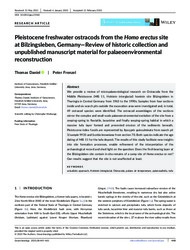Pleistocene freshwater ostracods from the Homo erectus site at Bilzingsleben, Germany—Review of historic collection and unpublished manuscript material for palaeoenvironmental reconstruction
Persistent URL: http://resolver.sub.uni-goettingen.de/purl?gldocs-11858/10909
 |
Dokument öffnen: |
We provide a review of micropalaeontological research on Ostracoda from the Middle Pleistocene (MIS 11, Holstein interglacial) hominin site Bilzingsleben in Thuringia in Central Germany from 1963 to the 1990s. Samples from four sections inside and six search pits outside the excavation area were investigated and, in total, 49 ostracod species were identified. The ostracod assemblages of the sections mirror the complex and small‐scale palaeoenvironmental evolution of the site from a seeping‐spring to fluviatile, lacustrine and finally seeping‐spring habitat in which a massive tufa layer formed and prevented erosion of the sediments beneath. Pleistocene index fossils are represented by
Statistik:
ZugriffsstatistikSammlung:
Schlagworte:
actualistic approachHolstein interglacial
Ostracoda
palaeo air temperature
palaeosalinity
tufa

